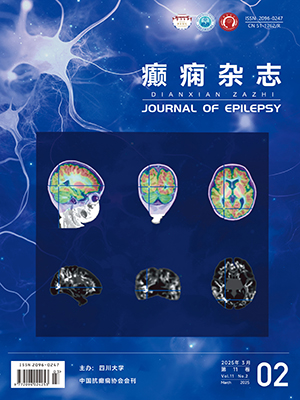| 1. |
He C, Chen F, Li B, et al. Neurophysiology of HCN channels: from cellular functions to multiple regulations. Prog Neurobiol, 2014, 112: 1-23.
|
| 2. |
Notomi T, Shigemoto R. Immunohistochemical localization of Ih channel subunits, HCN1-4, in the rat brain. J Comp Neurol, 2004, 471(3): 241-276.
|
| 3. |
Powell KL, Ng C, O'Brien TJ, et al. Decreases in HCN mRNA expression in the hippocampus after kindling and status epilepticus in adult rats. Epilepsia, 2008, 49(10): 1686-1695.
|
| 4. |
Kumar S, Stecher G, Tamura K. MEGA7: molecular evolutionary genetics analysis version 7.0 for bigger datasets. Mol Biol Evol, 2016, 33(7): 1870-1874.
|
| 5. |
Wilkins MR, Gasteiger E, Bairoch A, et al. Protein identification and analysis tools in the ExPASy server. Methods Mol Biol, 1999, 112: 531-552.
|
| 6. |
Reddy BV. Structural distribution of dipeptides that are identified to be determinants of intracellular protein stability. J Biomol Struct Dyn, 1996, 14(2): 201-210.
|
| 7. |
Almagro Armenteros JJ, Tsirigos KD, Sonderby CK, et al. SignalP 5.0 improves signal peptide predictions using deep neural networks. Nat Biotechnol, 2019, 37(4): 420-423.
|
| 8. |
Kosugi S, Hasebe M, Tomita M, et al. Systematic identification of cell cycle-dependent yeast nucleocytoplasmic shuttling proteins by prediction of composite motifs. Proc Natl Acad Sci USA, 2009, 106(25): 10171-10176.
|
| 9. |
Kosugi S, Hasebe M, Matsumura N, et al. Six classes of nuclear localization signals specific to different binding grooves of importin alpha. J Biol Chem, 2009, 284(1): 478-485.
|
| 10. |
Chen Y, Yu P, Luo J, et al. Secreted protein prediction system combining CJ-SPHMM, TMHMM, and PSORT. Mamm Genome, 2003, 14(12): 859-865.
|
| 11. |
Blom N, Sicheritz-Ponten T, Gupta R, et al. Prediction of post-translational glycosylation and phosphorylation of proteins from the amino acid sequence. Proteomics, 2004, 4(6): 1633-1649.
|
| 12. |
Letunic I, Bork P. 20 years of the SMART protein domain annotation resource. Nucleic Acids Res, 2018, 46(D1): D493-D496.
|
| 13. |
Sapay N, Guermeur Y, Deleage G. Prediction of amphipathic in-plane membrane anchors in monotopic proteins using a SVM classifier. BMC Bioinformatics, 2006, 7: 255.
|
| 14. |
Waterhouse A, Bertoni M, Bienert S, et al. SWISS-MODEL: homology modelling of protein structures and complexes. Nucleic Acids Res, 2018, 46(W1): W296-W303.
|
| 15. |
Szklarczyk D, Morris JH, Cook H, et al. The STRING database in 2017: quality-controlled protein-protein association networks, made broadly accessible. Nucleic Acids Res, 2017, 45(D1): D362-D368.
|
| 16. |
Reese MG. Application of a time-delay neural network to promoter annotation in the Drosophila melanogaster genome. Comput Chem, 2001, 26(1): 51-56.
|
| 17. |
Knudsen S. Promoter2.0: for the recognition of PolII promoter sequences. Bioinformatics, 1999, 15(5): 356-361.
|
| 18. |
Solovyev VV, Shahmuradov IA, Salamov AA. Identification of promoter regions and regulatory sites. Methods Mol Biol, 2010, 674: 57-83.
|
| 19. |
Plake C, Schiemann T, Pankalla M, et al. AliBaba: PubMed as a graph. Bioinformatics, 2006, 22(19): 2444-2445.
|
| 20. |
Farre D, Roset R, Huerta M, et al. Identification of patterns in biological sequences at the ALGGEN server: PROMO and MALGEN. Nucleic Acids Res, 2003, 31(13): 3651-3653.
|
| 21. |
Carver T, Bleasby A. The design of Jemboss: a graphical user interface to EMBOSS. Bioinformatics, 2003, 19(14): 1837-1843.
|
| 22. |
Li LC, Dahiya R. MethPrimer: designing primers for methylation PCRs. Bioinformatics, 2002, 18(11): 1427-1431.
|
| 23. |
Brown HF, DiFrancesco D, Noble SJ. How does adrenaline accelerate the heart? Nature, 1979, 280(5719): 235-236.
|
| 24. |
Tibbs GR, Posson DJ, Goldstein PA. Voltage-gated ion channels in the PNS: novel therapies for neuropathic pain? Trends Pharmacol Sci, 2016, 37(7): 522-542.
|
| 25. |
Poller WC, Bernard R, Derst C, et al. Lateral habenular neurons projecting to reward-processing monoaminergic nuclei express hyperpolarization-activated cyclic nucleotid-gated cation channels. Neuroscience, 2011, 193: 205-216.
|
| 26. |
Noam Y, Ehrengruber MU, Koh A, et al. Filamin A promotes dynamin-dependent internalization of hyperpolarization-activated cyclic nucleotide-gated type 1 (HCN1) channels and restricts Ih in hippocampal neurons. J Biol Chem, 2014, 289(9): 5889-5903.
|
| 27. |
Weng XC, Liu SJ. [Role of HCN channels in the nervous system: membrane excitability and various modulations]. Zhongguo Ying Yong Sheng Li Xue Za Zhi, 2014, 30(6): 506-510.
|
| 28. |
Sarkisian MR, Bartley CM, Rakic P. Trouble making the first move: interpreting arrested neuronal migration in the cerebral cortex. Trends Neurosci, 2008, 31(2): 54-61.
|
| 29. |
Cao-Ehlker X, Zong X, Hammelmann V, et al. Up-regulation of hyperpolarization-activated cyclic nucleotide-gated channel 3 (HCN3) by specific interaction with K+ channel tetramerization domain-containing protein 3 (KCTD3). J Biol Chem, 2013, 288(11): 7580-7589.
|
| 30. |
Zagotta WN, Olivier NB, Black KD, et al. Structural basis for modulation and agonist specificity of HCN pacemaker channels. Nature, 2003, 425(6954): 200-205.
|
| 31. |
DeBerg HA, Brzovic PS, Flynn GE, et al. Structure and Energetics of Allosteric Regulation of HCN2 Ion Channels by Cyclic Nucleotides. J Biol Chem, 2016, 291(1): 371-381.
|
| 32. |
Jones PA. Functions of DNA methylation: islands, start sites, gene bodies and beyond. Nat Rev Genet, 2012, 13(7): 484-492.
|
| 33. |
Sulewska A, Niklinska W, Kozlowski M, et al. DNA methylation in states of cell physiology and pathology. Folia Histochem Cytobiol, 2007, 45(3): 149-158.
|




